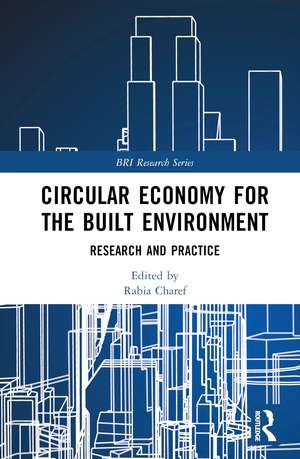Circular Economy for the Built Environment: Research and Practice: BRI Research Series
Editat de Rabia Charefen Limba Engleză Hardback – 3 iun 2024
The book adopts a trans-scalar perspective by traversing the entire spectrum of building phases from initial programming to the recovery phase, as well as from the scale of materials to the scale of buildings, offering a profound examination of the intricate dynamics involved in the offer/demand for recovered materials. This book highlights the paramount need to harmonize research with practical applications. By spotlighting effective circular practices and elucidating the challenges faced by practitioners, it identifies fertile grounds for further research. Moreover, the book extends its reach by offering practical ideas on how practitioners can seamlessly adopt a circular approach in both thought and realization.
Circular Economy for the Built Environment: Research and Practice is a must-read book for students, researchers, academics, and practitioners in the fields of architecture, planning, engineering, construction, and real estate. This book provides a compelling narrative that bridges the theoretical and practical realms of the circular economy in the built environment.
Preț: 1054.71 lei
Preț vechi: 1286.24 lei
-18% Nou
Puncte Express: 1582
Preț estimativ în valută:
201.85€ • 209.95$ • 166.63£
201.85€ • 209.95$ • 166.63£
Carte tipărită la comandă
Livrare economică 15-29 aprilie
Livrare express 08-14 martie pentru 48.03 lei
Preluare comenzi: 021 569.72.76
Specificații
ISBN-13: 9781032573755
ISBN-10: 1032573759
Pagini: 294
Ilustrații: 122
Dimensiuni: 156 x 234 x 18 mm
Greutate: 0.45 kg
Ediția:1
Editura: CRC Press
Colecția Routledge
Seria BRI Research Series
Locul publicării:Boca Raton, United States
ISBN-10: 1032573759
Pagini: 294
Ilustrații: 122
Dimensiuni: 156 x 234 x 18 mm
Greutate: 0.45 kg
Ediția:1
Editura: CRC Press
Colecția Routledge
Seria BRI Research Series
Locul publicării:Boca Raton, United States
Public țintă
Academic and PostgraduateCuprins
Part I. Setting the foundation for circular construction. 1. The future of the circular built environment: interest of a “low-tech” approach. 2. The reuse of building elements: touchstone of a circular construction economy. 3. Buildings as material mines – towards digitalization of resource cadasters for circular economy. 4. Boosting construction waste material circularity: A sharing economy approach. 5. The role of standardisation in circular economy for the construction sector. Part II. Practical strategies for circular construction: building and material levels. 6. How can we view buildings as material banks? Learning from the pre-redevelopment process. 7. The potential for reusing reinforced concrete beams: technical feasibility and environmental impact. 8. Building together with the site materials: a practitioner’s perspective. 9. Towards a situated understanding of challenges in the design and construction of circular earth buildings: the case study of an office building in France. Part III. Fostering circular construction through digital transformation. 10. Digitalizing the deconstruction process: towards a circular economy for the construction industry. 11. Accelerating material reuse in construction: two case studies: one life, multiple cycles, a longer life. 12. Additive manufacturing and circular economies.
Notă biografică
Dr Rabia Charef serves as a Research Associate at Lancaster University (UK) actively contributing to the establishment of a circular future. With an extensive 15 years of industry experience, she spent over a dozen years leading intricate architectural projects in the residential and healthcare sectors. Transitioning to academia, she leverages her industry insights to fuel research closely tied to practitioners’ needs and challenges, taking a bottom‑up approach.
Descriere
This provides an overview of the circular economy in the built environment, presenting a fusion of insights from researchers and practitioners. Chapters cover pivotal themes, including the transformative concept of buildings as material banks, innovative design approaches, and the potential of digitalization for a circular built environment.





